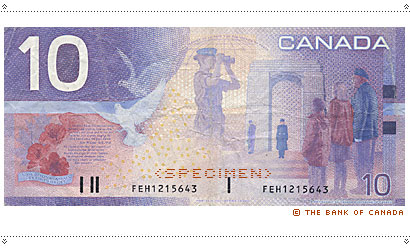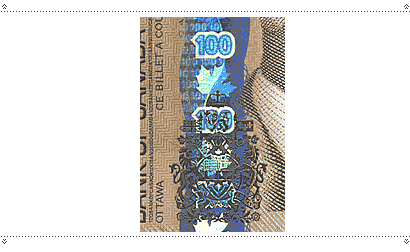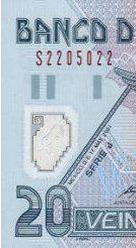Canada got the 4th in a series of new banknotes on Wednesday. I don’t know if we Canadians revamp our money more often than most other nations, but in my lifetime I’ve seen 4 complete redesigns of our paper currency (+1 for our Centennial year in 1967. Yes, I’m that old). We also mint coins like they’re made out of chocolate but that is definitely another post.
Our new series is sortof an odd design mix between Dutch-influence and a vaguely Fascist heroism (my Italian boyfriend disagrees with me on this, and he should know, but I can’t help but seeing it still). The designs for the series were completed by design teams at Canadian Bank Notes (CBN) and BA International, led by Jorge Peral, Artistic Director at CBN.
The series kicked off several years ago with the $10 bill on the theme of “Remembrance and Peacekeeping,” and is the one that reminds me the most of Italian fascist-era graphics, though perhaps it’s just the war memorial monument. What strikes me as amusing is the depiction of a young woman, boy and (presumably) grandfather standing in the foreground wearing decidedly … um … inelegant clothes. I’m not sure what people should be depicted wearing while hanging around on the backs of money for all eternity, but I love the way the boy is dressed in an oversized, misshapen parka, with his arms hanging listlessly at his sides (at least he’s not pointing with enthusiasm at the monument). They look perfectly Canadian, actually, and I approve.

There is a quotation from the poem “In Flanders Fields” by John McCrae. Each bill in the series has a literary quote set in near-impossible-to-read type (“Can you bump this up a size or 6?”), and I like that, too.
Next up, over 2 years ago we got a very charming new $5 bill (why they don’t issue them in denominational sequence is beyond me), with a winter play theme featuring a game of outdoor hockey that includes a girl player—how very PC of them. Not only is this my favourite of the bills by far, it also has a great quotation from the famous story, “The Hockey Sweater,” by Roch Carrier. Very Canadian, with a kind of innocence I’ve never seen on any currency anywhere. How could you look at this and not love us completely?

Earlier this year, the new $100 bill was issued. It reminds me oddly of … the new UPS logo. This one has a theme of “Exploration and Innovation” and heralds what will soon be antiquated space junk: they should have stuck with themes of longevity like hockey or fishing. Well, no, maybe not fishing. Anyway, I was all set to pronounce this bill “butt ugly,” until I got my hands on one. One-hundred dollar bills are not dispensed from cash machines, so for the sake of Speak Up readers I made a special trip to the bank to get one.

Luckily the one I got is in mint condition and it positively shimmers with security features (see more below). There’s an overprint of spot varnish in places that looks so much like envelope glue I’m tempted to lick it. There’s a ribbon of irridescent foil on the front that is so beautiful I can’t stop playing with it (it looks mostly copper coloured, but as you can see below it has scanned as blue). And it in turn is engraved with a positively stunningly detailed Canadian crest. I’m going to have a hard time handing this over to a cashier in exchange for toilet paper and some change.

The $20 bill that was just unveiled is unlikely to reach my wallet for a while, so all I have to go on is from the Bank of Canada Website (a very nicely organized and designed site, by the way). This one, interestingly, depicts the art of the Haida artist, Bill Reid, the studio of whom was a client of mine while he was alive. It predominantly features the sculpture “The Spirit of Haida Gwaii,” which I’m a little tired of as it has become somewhat of a default native-Canadian icon, versions being here at the Vancouver Airport and at the Canadian Embassy in Washington, with the original plaster at the Museum of Civilization in Quebec.
In many ways this new $20 disappoints me the most. Where the $5 has a dynamism and unusual, yes, playfulness (snowflakes!); the $10 has that unintended humour buried in its predictable iconography; and the $100 has that gradient, the $20 seems to squander an opportunity to use the natural graphic sensibilites of Haida art (issues of cultural appropriation aside). Instead, they have chosen to float four artefacts in and around each other in a distinctly Photoshop sea, without connection to each other or to the graphics of the bill itself. Admittedly, it could be worse, but given the source material, it could be so, so much better.
The fronts of all of these are all similar in design, featuring one of a few past Prime Ministers who most people have forgotten: Laurier, Macdonald and … um … Borden (had to look that up: never heard of him), and our Queen, who we share with England. The Aging of the Queen as Represented on Money and Stamps is perhaps another post, but let’s just say that assuming they’re still flattering her, she’s not looking too good, poor thing.
Of course the design of money is a science of useability and security, and in this respect they certainly measure up, to my eyes.
Our money has been colour coded in blue (5), purple (10), green (20), red (50) and brown (100) since, well, at least since I was born. The 1969–79 series was famously a riot of colour, but still within that range.
On our new series, the denominations are very clearly printed in large—and I mean honking big numbers on both front and back, and if that’s an identifiable typeface I’d love to know what it is: I simply love the shape of the “0” … on the ten, anyway—the face has been disturbingly condensed or changed on the 100.

And just in case you actually are so blind you can’t see that, each bill is embossed with braille. Except, maybe there’s something about braille that only the blind understand but it looks/feels exactly the same on the 5 as the 100 (6 dots). The braille tends to get worn down pretty quickly, but nice effort anyway.
The security features are many and varied, including holographic stripes, security threads, watermarks, “see through numbers,” flourescing inks and fibres that glow under UV light. Probably pretty standard stuff, but it all looks and sounds cool to me.
In all, I’m happy to see these new notes replace the 1986 series. The design of the latter was an intense disappointment to me as its dull and not-particularly-well-rendered graphics replaced what must surely be one of the more psychedelic set of banknotes on the planet, those of the 1969–79 Series (check out the mouseovers), designed by Thomas de la Rue. The first issue of the $20 of that series was purportedly too green and thus confusing with the $1 (by the colour-blind, presumably), following which it was re-released in distinctly, er, fruit-loop colours.
Call me tacky, or perhaps just predictable, but those really were my favourites, despite the oil refinery on the back of the $10 (with the simple 1954 series, designed by Charles S. Comfort, running a close second). The $50 of that time is my second favourite note in the world, next only to the Dutch 50 Guilder. It had an image of the Mounties’ Musical Ride on the back that was so finely rendered you could see the maple leaf which they back-brush by stencil into the hair on the horses’ rumps. How cool is that?


I guess the $50 is the next up for the new series. I’ll be waiting in restless anticipation to see if they’ll restore some of that former glory in it.










Ahh, the queen. Isn't she cute? That's a pretty good picture of her on the new 20.
Great post, Marian! I have to agree with you about the 50 Guilder note's fantastic-ness.
One of my all-time favourites is Sweden's 20 Kronor note.
On Oct.01.2004 at 05:20 AM